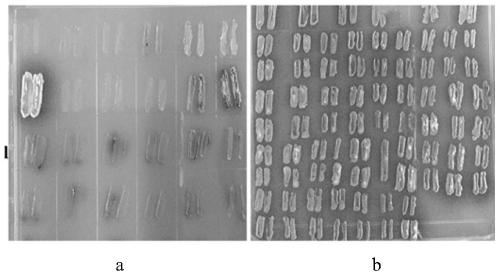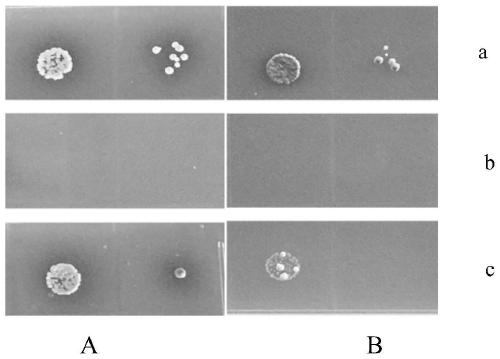Yeast two-hybrid method
A yeast two-hybrid and yeast technology, applied in the field of genetic engineering, can solve the problems of false negative screening results and wrong conformation of fusion proteins, and achieve the effects of increasing the positive clone rate, improving the interaction, and increasing the detection rate.
- Summary
- Abstract
- Description
- Claims
- Application Information
AI Technical Summary
Problems solved by technology
Method used
Image
Examples
Embodiment 1
[0024] A yeast two-hybrid method, the specific steps comprising:
[0025] 1) The library containing three reading frames is preserved in the form of yeast Y187. Activate before use. Dilute 2ml of the AD-cDNA library from tissues or cells 10 times with SD / -LEU liquid medium, spread evenly to SD / -LEU solid medium (100 plates) and culture for 5 days, use a glass rod Scrape and mix all the yeasts and divide into centrifuge tubes to obtain activated yeast library, add glycerol and store at -80°C. The titer of the yeast library was measured by 10-fold serial dilution, and the volume of the original library bacterial solution required to amplify the library was calculated; two proteins interacted as: ZFP36 and OsLEA5, and the AD-ZFP36 fusion vector was transformed by electroporation into yeast Y187 and preserved in SD / -LEU;
[0026] 2) Transform the bait plasmid BD-OsLEA5 into yeast cell Y2H Gold by electroporation to obtain recombinant yeast expressing the bait protein BD-OsLEA5,...
Embodiment 2
[0029] The comparison group is a yeast two-hybrid method, the steps of which are basically the same as in Example 1, and the medium used in step (3) is the same as that of Example 1 except that it does not contain zinc ions.
[0030] The blue single bacterium colony obtained in embodiment 1 is compared with the blue single bacterium colony obtained by the contrast group and finds, as figure 1 , a is a comparison group, and b is Example 1. It can be seen that the colony spots on the b diagram are obviously more than that of the a diagram, which shows that the positive clone rate obtained by a yeast two-hybrid method described in the present disclosure is obviously higher Compared with the comparison group, it shows that the method of the present disclosure can improve the positive cloning rate, and further confirm the positive results at the end, such as figure 2 , a is the comparison group, and b is Example 1. It can be seen that the method of the present disclosure can reduc...
PUM
 Login to View More
Login to View More Abstract
Description
Claims
Application Information
 Login to View More
Login to View More - R&D
- Intellectual Property
- Life Sciences
- Materials
- Tech Scout
- Unparalleled Data Quality
- Higher Quality Content
- 60% Fewer Hallucinations
Browse by: Latest US Patents, China's latest patents, Technical Efficacy Thesaurus, Application Domain, Technology Topic, Popular Technical Reports.
© 2025 PatSnap. All rights reserved.Legal|Privacy policy|Modern Slavery Act Transparency Statement|Sitemap|About US| Contact US: help@patsnap.com



